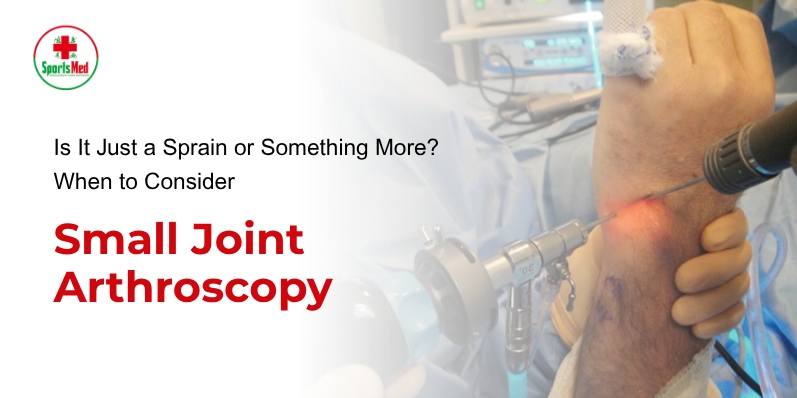
Is It Just a Sprain or Something More? When to Consider Small Joint Arthroscopy
Sprain vs. Something More Serious
Joint pain is usually dismissed as a simple sprain if injury has occurred following a fall, twisting motion, or a sports-related incident. What may seem like a minor injury may be serious. What may seem like a sprain could be signs of a ligament being torn, cartilage damage, or a concealed fracture. The symptoms do not clear out or worsen, and thus, it is a prerequisite to investigate beyond the surface whether advanced diagnostics like small joint arthroscopy are needed.
Pain and Tenderness
Most sprains cause mild to moderate pain, which is aggravated by the length of time during which the sharp pain is experienced as possible signs of severe injuries. Local tenderness on specific joints, such as the wrist, ankle, elbow, or fingers, could indicate structural damage that warrants investigation.
Swelling
Typically, swelling forms due to inflammation after a sprain. However, excessive or prolonged swelling, especially if it generates heat or a sensation of tightness, could mean joint effusion, bleeding into the joint, or tearing of internal structures. Swelling that does not reduce within several days should never be overlooked.
Bruising
The formation of bruises on or around a joint may be indicative of the leaking of blood from damaged ligaments, tendons, or blood vessels. Though occasional sprain-caused bruising may be considered minor, deep or widespread bruising may tip the scales toward major tissue damage or a fracture.
Limited Movement
The joint feels stiff, unstable, and maybe it has a limited range of motion; then it could be that the problem is cramping, more than just a simple sprain. Structural injuries like cartilage tears, tendon ruptures, or even loose bone fragments may impair the normal motion and create some long-term mobility problems if these remain untreated.
A Popping or Tearing Sensation
A rather loud "pop" or similar torn sensation felt during the injury is more compatible with ligament rupture or tendon tear than with a mere sprain. These injuries frequently call for imaging and, at times, surgical repair.
Signs You Might Need Imaging or Arthroscopy
When any of the below symptoms occur, it is time to put away conservative measures and consider further investigations. Arm or leg pain for more than 7–10 days, even with rest
-
Feeling of joint instability or weakness
-
Difficulty in weight bearing or using the joint
-
Locking or clicking sounds and/or grinding sensations
-
Swelling or flare-ups that come periodically
Imaging tests, X-rays, and MRI are helpful, but they may fail to detect subtle or internal joint damage when it comes. And then comes small joint arthroscopy.
What Is Small Joint Arthroscopy?
The less invasive surgical method of diagnosis and treatment in joints relates to small joint arthroscopy. A small incision is made to insert the arthroscope or the camera, allowing the surgeon to view joint structures in real time. During the same procedure, with the use of specific instruments, damage to the joint may also be repaired.
The use of this procedure becomes especially valuable in cases where imaging tests may provide inconclusive findings or conservative treatment options fail to relieve symptoms.
Benefits of Small Joint Arthroscopy
-
Diagnosis Accuracy: It gives a direct visual confirmation of cartilage tears, damaged ligaments, or loose fragments.
-
Minimally Invasive: Small incisions disrupt less tissue, promote faster healing, and reduce the risk of infection.
-
Double Diagnosing: It can treat the problems in the same session if required.
-
Quick Homecoming: Patients typically get back to their usual activities sooner compared to conventional open surgery.
-
Less Scarring: Due to their small size, incisions cause minimal scarring, which is appreciated for surgeries involving hands, wrists, or ankles.
When Should You Talk to a Specialist?
If, after a week of use of the RICE method, nothing satisfies the symptoms, or the joint still feels unstable to some degree or is painful, one must see a sports injury or orthopedic specialist. Early care can help prevent chronic joint problems and better regain function.
Conclusion
A harmless sprain may potentially be a more serious injury. Recognizing red flags such as continuing pain, joint instability, loss of function, or a popping sensation can allow for timely treatment. Small joint arthroscopy is a fairly simple and elegant option that can be used to diagnose and treat hidden joint damage when other diagnostic procedures are inconclusive. Do not wait until the minor discomfort turns into a long-term condition; whenever in doubt, seek an expert's opinion.